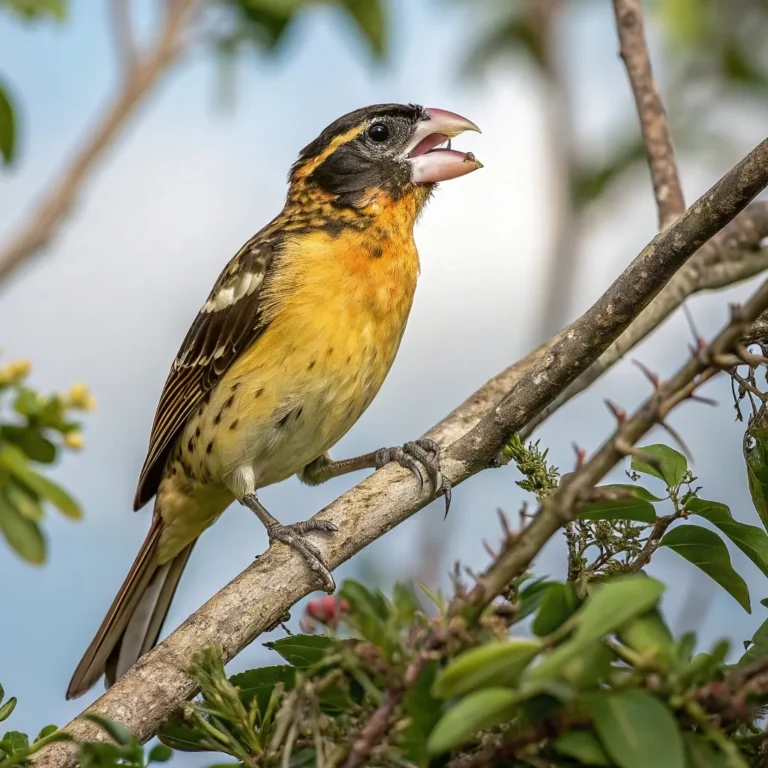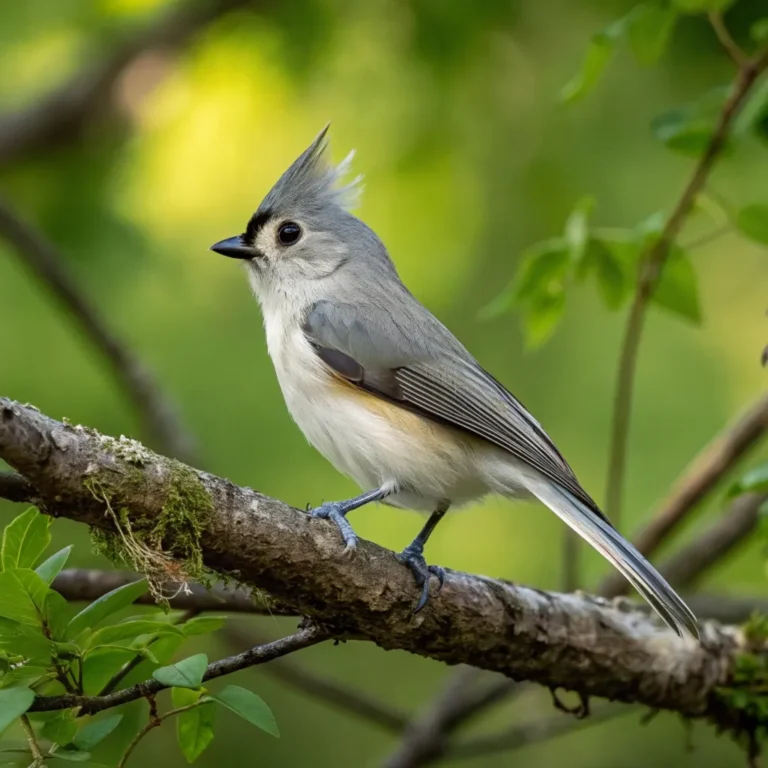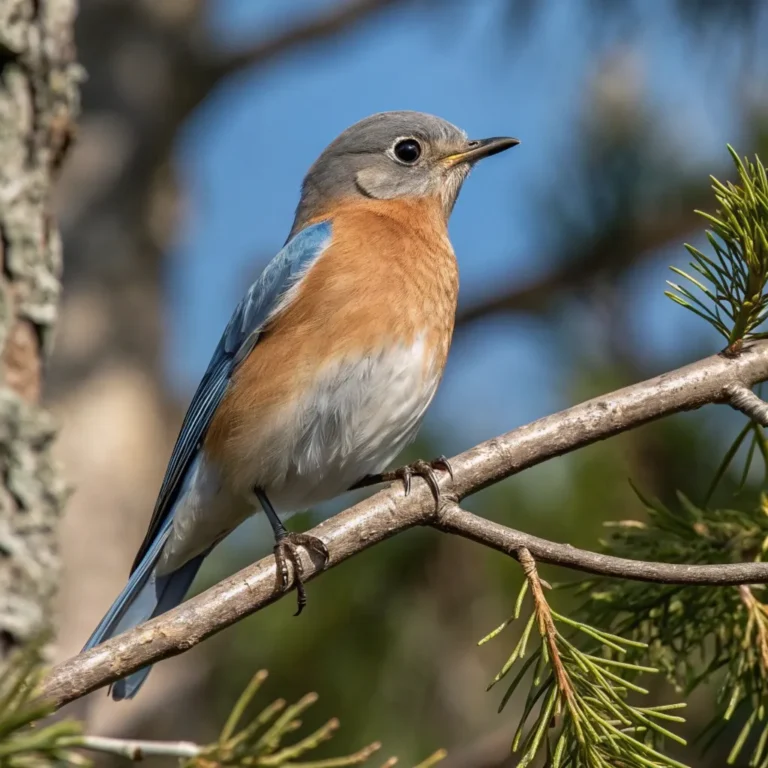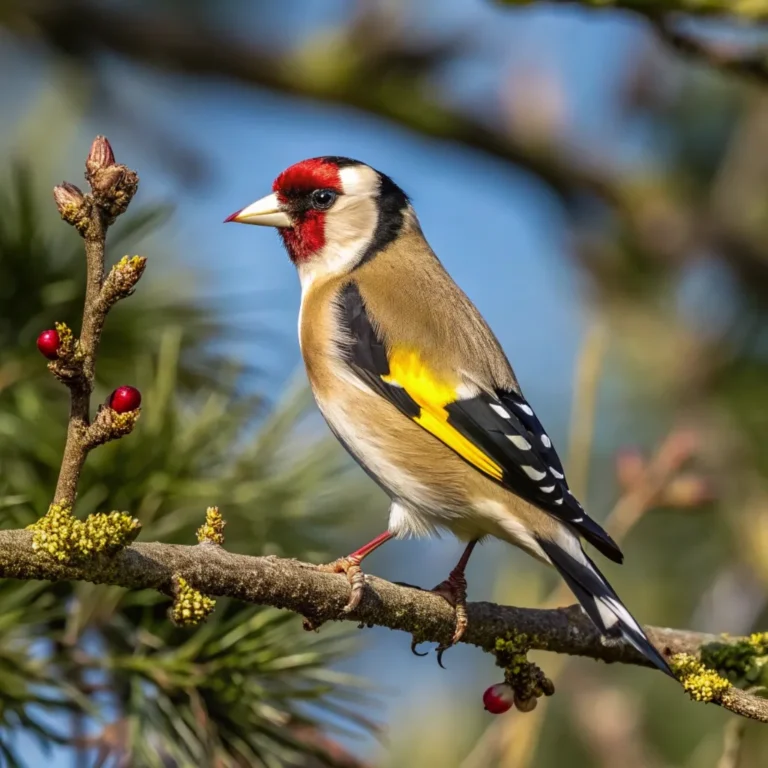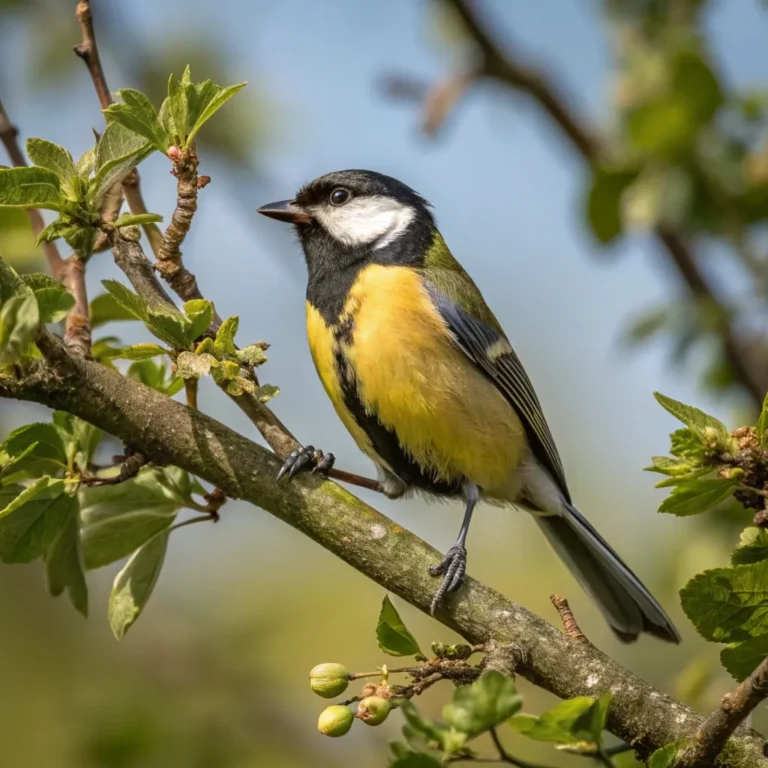The 20 Fastest Birds in the World: Speed Records and Fascinating Facts
Birds amaze us with their ability to fly. Some birds can reach incredible speeds. This article explores the 20 fastest birds on Earth. We will look at their speed records and interesting facts.
The world of fast-flying birds is exciting. From diving falcons to swift-winged ducks, these birds show nature’s amazing designs.
We’ll discover how they achieve such high speeds and why speed matters in their lives.
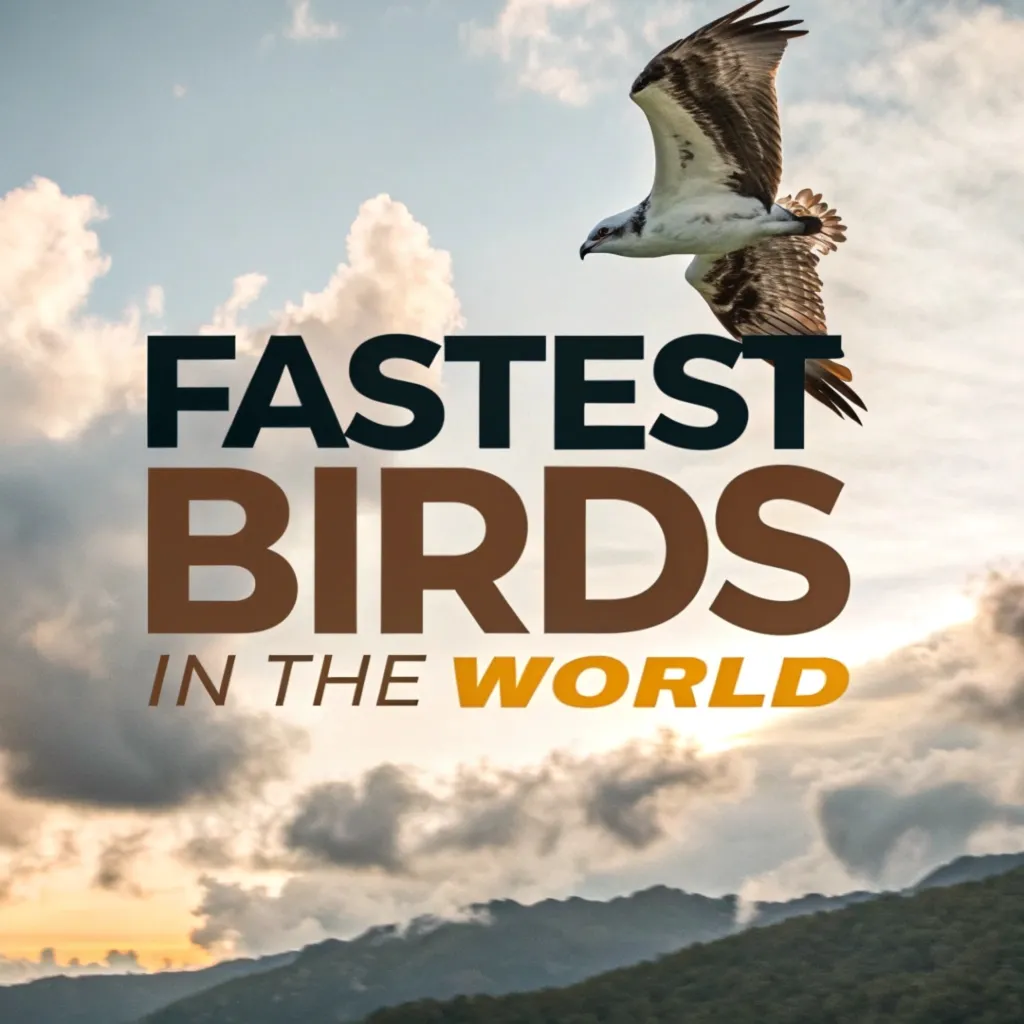
Key Takeaways: Speed Champions of the Avian World
- Peregrine Falcon reigns supreme, reaching 389 km/h (242 mph) in diving speed.
- Golden Eagle and Saker Falcon follow closely, both achieving around 320 km/h (200 mph) in dives.
- White-throated Needletail holds the unconfirmed record for fastest horizontal flight at 169 km/h (105 mph).
- Common Swift boasts the confirmed fastest level flight at 111.6 km/h (69.3 mph).
- Frigatebirds combine speed with endurance, flying at 153 km/h (95 mph) and staying aloft for weeks.
- Red-breasted Merganser is the fastest duck, clocking 130 km/h (81 mph).
- Eurasian Hobby showcases agility with speeds up to 159 km/h (99 mph).
- Spur-winged Goose is the fastest waterfowl at 143 km/h (89 mph).
- Canvasback and Common Eider represent fast-flying ducks at around 125 km/h (78 mph).
- Anna’s Hummingbird demonstrates impressive speed for its size at 70 km/h (43 mph).
- Ostrich, though flightless, matches the Anna’s Hummingbird’s speed on land.
- Gentoo Penguin is the fastest swimming bird at 36 km/h (22 mph) in water.
- Speed serves various purposes: hunting, escaping predators, and efficient migration.
- Diving birds generally achieve higher speeds compared to level flight.
- Aerodynamic adaptations play a crucial role in enabling high-speed flight.
- Research on these birds contributes to advancements in aviation, robotics, and conservation.
Peregrine Falcon: The Undisputed Speed Champion
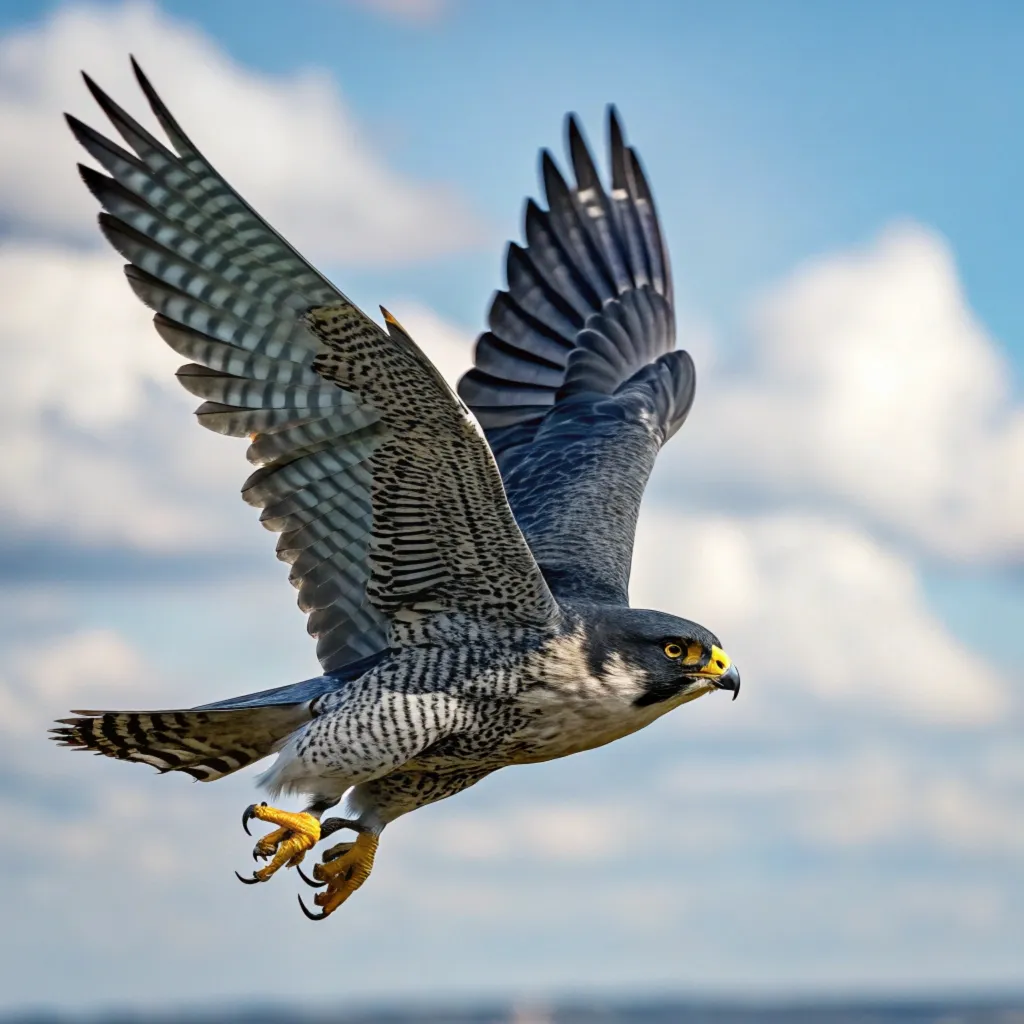
The Peregrine Falcon (Falco peregrinus) holds the title of fastest bird in the world. This remarkable raptor achieves mind-boggling speeds during its hunting dives, known as stoops.
Speed Record: Peregrine Falcons reach velocities up to 389 km/h (242 mph) while diving. This makes them not only the fastest bird but also the fastest animal on the planet.
Hunting Technique: Peregrines employ their incredible speed to catch prey in mid-air. They climb to great heights, then fold their wings and plummet towards their target. The falcon strikes its prey with its feet, often knocking it out of the sky.
Adaptations for Speed:
- Aerodynamic body shape
- Pointed wings that tuck close to the body during dives
- Strong flight muscles
- Specialized respiratory system to handle high-speed flight
Conservation Success: Peregrine Falcons faced near-extinction due to DDT pesticide use. Thanks to conservation efforts, they have made a remarkable recovery and now thrive in many urban areas.
The Peregrine Falcon’s incredible speed is not just a product of its physical adaptations, but also its hunting strategy. These birds have developed a unique technique for maximizing their velocity during dives.
By folding their wings tightly against their body, they create a teardrop shape that minimizes air resistance.
This aerodynamic posture allows them to achieve speeds that would be impossible in level flight, making them the undisputed champions of avian speed.
Research into Peregrine Falcon flight has revealed fascinating insights into the physics of high-speed diving. Scientists have discovered that these birds possess special adaptations in their nostrils that help regulate airflow at extreme speeds.
Additionally, their visual system is highly specialized, allowing them to maintain focus on their prey even while plummeting at breakneck velocities.
These findings not only enhance our understanding of avian biology but also provide inspiration for technological innovations in fields like aviation and sports equipment design.
Golden Eagle: Powerful Diver

The Golden Eagle (Aquila chrysaetos) ranks as the second-fastest bird when diving speeds are considered.
Speed Record: Golden Eagles achieve diving speeds of up to 320 km/h (199 mph).
Size and Power: As North America’s largest bird of prey, Golden Eagles combine size with speed. Their wingspan can reach an impressive 2.2 meters (7.2 feet).
Hunting Prowess: Golden Eagles use their speed and power to hunt a variety of prey, including:
- Rabbits
- Marmots
- Ground squirrels
- Occasionally larger animals like deer
Habitat: These majestic birds inhabit open areas near mountains, hills, and cliffs across the Northern Hemisphere.
The Golden Eagle’s impressive size and speed make it a formidable predator in its ecosystem. These birds possess incredible strength, allowing them to take down prey much larger than themselves.
Their powerful talons can exert pressure up to 440 pounds per square inch, which is stronger than the bite force of a wolf.
This combination of speed, size, and strength makes the Golden Eagle a top predator in many of its habitats, playing a crucial role in maintaining ecological balance.
Golden Eagles have long held a special place in human culture and mythology. Many ancient civilizations, including the Greeks, Romans, and various Native American tribes, revered these birds as symbols of power and divinity.
In modern times, Golden Eagles continue to captivate researchers and wildlife enthusiasts alike. Their ability to adapt to various habitats, from Arctic tundra to desert mountains, showcases their resilience and ecological importance.
Conservation efforts focus on protecting their nesting sites and maintaining the open landscapes they need for hunting.
Saker Falcon: Swift Hunter of the Steppes

The Saker Falcon (Falco cherrug) demonstrates impressive speed in both level flight and dives.
Speed Records:
- Level Flight: Up to 150 km/h (93 mph)
- Diving: Estimated 320 km/h (200 mph)
Falconry: Saker Falcons are highly prized in falconry for their speed and hunting ability.
Habitat: These falcons typically inhabit open landscapes like steppes and grasslands across Eurasia.
The Saker Falcon’s remarkable speed is complemented by its exceptional maneuverability. These birds are capable of making sharp turns and rapid direction changes while maintaining high velocities, a skill that makes them formidable hunters.
Their ability to fly at high speeds close to the ground allows them to surprise prey and navigate complex terrain.
This combination of speed and agility has made Saker Falcons highly valued in the ancient art of falconry, where they are considered one of the most prestigious and effective hunting birds.
Conservation efforts for Saker Falcons face unique challenges due to their popularity in falconry. The high demand for these birds has led to illegal trapping and trade, putting pressure on wild populations.
Conservationists are working to implement sustainable falconry practices and protect critical habitats. Efforts include captive breeding programs, habitat restoration, and international cooperation to regulate trade.
These initiatives aim to ensure that Saker Falcons continue to thrive in their natural habitats while maintaining their cultural significance in falconry traditions.
White-throated Needletail: Horizontal Speed Specialist

The White-throated Needletail (Hirundapus caudacutus) holds an unconfirmed record for fastest horizontal flight.
Claimed Speed: Up to 171 km/h (106 mph) in level flight
Unique Features:
- Barrel-shaped body
- Long, pointed wings
- Distinctive white throat and tail spines
Aerial Lifestyle: These swifts spend most of their lives on the wing, rarely landing except to nest.
Migration: White-throated Needletails breed in Asia and winter in Australia, covering vast distances during migration.
The White-throated Needletail’s exceptional speed in horizontal flight is a result of its highly specialized anatomy. These birds have evolved to maximize efficiency in sustained, high-speed flight.
Their barrel-shaped bodies reduce drag, while their long, pointed wings provide excellent lift and propulsion. The tail spines, unique to this species, are believed to help with aerodynamic stability at high speeds.
These adaptations allow White-throated Needletails to cover vast distances during migration with remarkable efficiency.
Research into the White-throated Needletail’s flight capabilities has been challenging due to their aerial lifestyle and the difficulty of tracking such fast-moving birds.
However, recent advancements in tracking technology and high-speed photography have provided new insights into their flight behavior.
Scientists are particularly interested in understanding how these birds maintain their speed over long distances and how they navigate during their extensive migrations.
This research not only enhances our knowledge of avian biology but also has potential applications in the development of long-range, high-speed aircraft.
Common Swift: Confirmed Speed Record Holder

The Common Swift (Apus apus) holds the verified record for fastest level flight among birds.
Confirmed Speed: 111.6 km/h (69.3 mph) in horizontal flight
Aerial Adaptations:
- Crescent-shaped wings
- Streamlined body
- Ability to sleep on the wing
Impressive Endurance: Common Swifts can stay airborne for up to 10 months at a time, eating, drinking, and even sleeping while flying.
The Common Swift’s remarkable speed is just one aspect of its extraordinary aerial abilities. These birds have evolved to live almost entirely in the air, spending more time airborne than any other bird species.
Their unique wing structure allows them to maintain efficient flight at both high and low speeds, enabling them to catch insects on the wing and navigate diverse weather conditions.
The swift’s ability to sleep while flying is a testament to their extreme adaptation to an aerial lifestyle, showcasing the incredible diversity of avian evolution.
Research into Common Swift flight patterns has revealed fascinating insights into bird migration and endurance. Scientists have discovered that these birds can fly non-stop for incredibly long periods, with some individuals staying airborne for up to 10 months at a time.
This extreme endurance is made possible by their ability to enter a state of half-sleep, where one hemisphere of the brain remains active while the other rests.
These findings have implications for our understanding of sleep biology and have inspired research into long-duration unmanned aerial vehicles for applications in environmental monitoring and disaster response.
Frigatebird: Oceanic Speed Demon

Frigatebirds (Fregata sp.) combine speed with incredible endurance in their oceanic lifestyle.
Speed Record: Up to 153 km/h (95 mph) in level flight
Unique Adaptations:
- Enormous wingspan relative to body size
- Forked tail for precise maneuvering
- Lightweight skeleton
Aerial Prowess: Frigatebirds can stay aloft for weeks at a time, riding updrafts and air currents over vast stretches of ocean.
The Frigatebird’s impressive speed is matched by its remarkable endurance and unique flying techniques. These birds have mastered the art of soaring, using their enormous wingspan to ride thermal currents and wind patterns with minimal energy expenditure.
Their ability to stay aloft for extended periods is crucial for their survival, as they spend most of their lives over open ocean.
Frigatebirds are known for their kleptoparasitic behavior, using their speed and agility to chase and harass other seabirds, forcing them to regurgitate their catch.
Recent studies on Frigatebirds have revealed astonishing insights into their flight capabilities. Researchers have discovered that these birds can ascend to altitudes of over 4,000 meters (13,000 feet) and cover distances of up to 400 kilometers (250 miles) in a single day.
Even more remarkably, Frigatebirds have been observed entering slow-wave sleep for brief periods while soaring, allowing them to rest mid-flight.
These findings have significant implications for our understanding of avian physiology and have inspired research into long-endurance flight technologies for both civilian and military applications.
Red-breasted Merganser: Fastest Duck

The Red-breasted Merganser (Mergus serrator) claims the title of fastest duck species.
Speed Record: Up to 130 km/h (81 mph) in level flight
- Serrated bill for catching fish
- Crest feathers on the head
- Streamlined body for fast flight
Habitat: These ducks breed in northern regions and migrate to coastal areas in winter.
The Red-breasted Merganser’s impressive speed sets it apart from other duck species. Unlike many ducks that rely primarily on buoyancy and paddling for movement, Red-breasted Mergansers are adapted for rapid flight.
Their streamlined body and powerful wing muscles allow them to achieve velocities that surpass most other waterfowl. This speed is not just for show; it serves a crucial purpose in their hunting strategy.
Red-breasted Mergansers use their swift flight to pursue fish underwater, diving from the air to catch their prey by surprise.
Research into Red-breasted Merganser flight has provided valuable insights into avian biomechanics. Scientists have studied the unique wing structure and flight patterns of these ducks to understand how they achieve such high speeds.
This research has applications in aerodynamic design, potentially influencing the development of more efficient aircraft and watercraft.
Additionally, tracking the migration patterns of these fast-flying ducks has helped ornithologists better understand the impact of climate change on bird populations and their seasonal movements.
Eurasian Hobby
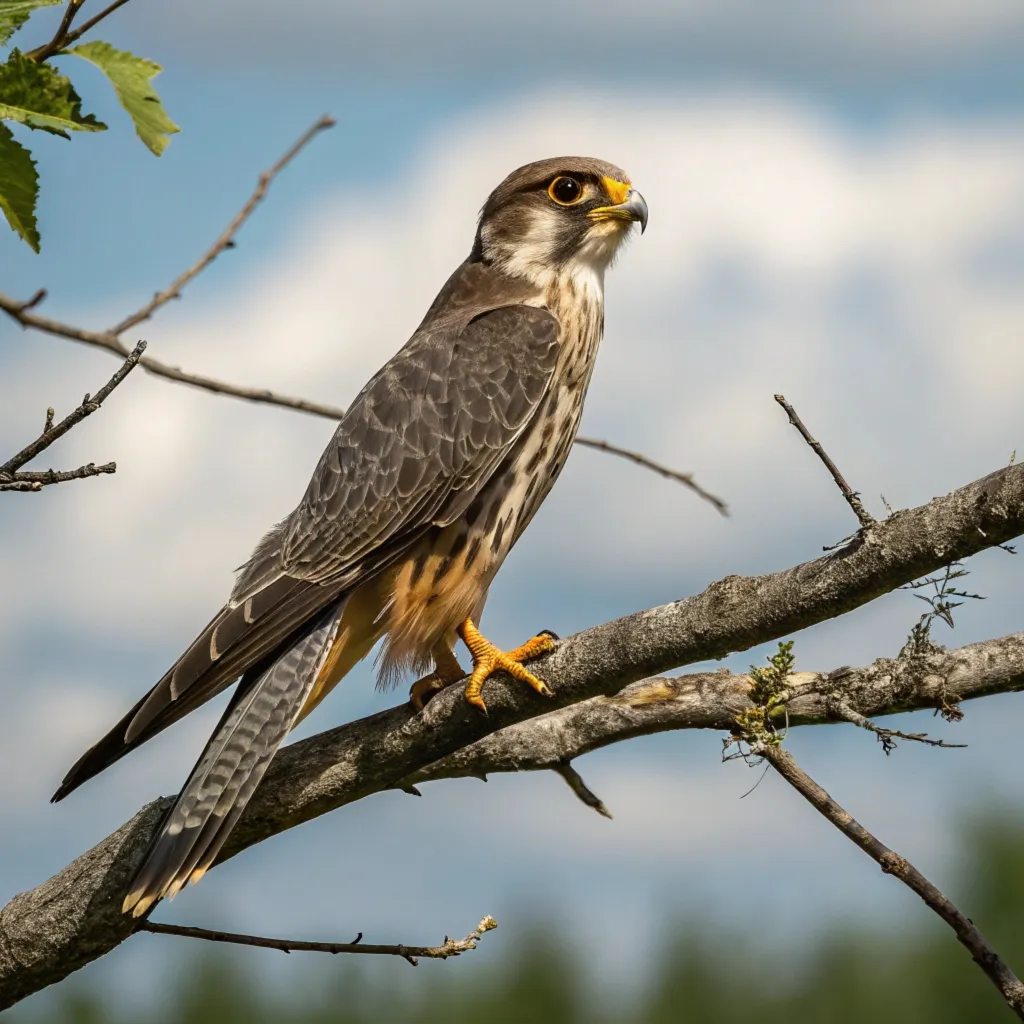
The Eurasian Hobby (Falco subbuteo) is a small falcon known for its agility and speed in flight. These birds can reach speeds of up to 160 km/h (100 mph) during hunting dives.
Their slender wings and streamlined body allow for rapid acceleration and precise maneuvering.
Eurasian Hobbies are particularly adept at catching flying insects and small birds in mid-air, showcasing their exceptional aerial skills.
Habitat adaptation plays a crucial role in the Eurasian Hobby’s flight capabilities. These falcons inhabit a variety of environments, from woodlands to open countryside, requiring versatile flying skills.
Their ability to quickly adjust their flight speed and direction makes them successful hunters in diverse landscapes.
Research into Eurasian Hobby flight patterns has provided valuable insights into predator-prey dynamics in aerial environments.
Scientists study these birds to better understand how flying predators influence the behavior and evolution of their prey species, contributing to our knowledge of ecosystem interactions.
Spur-Winged Goose
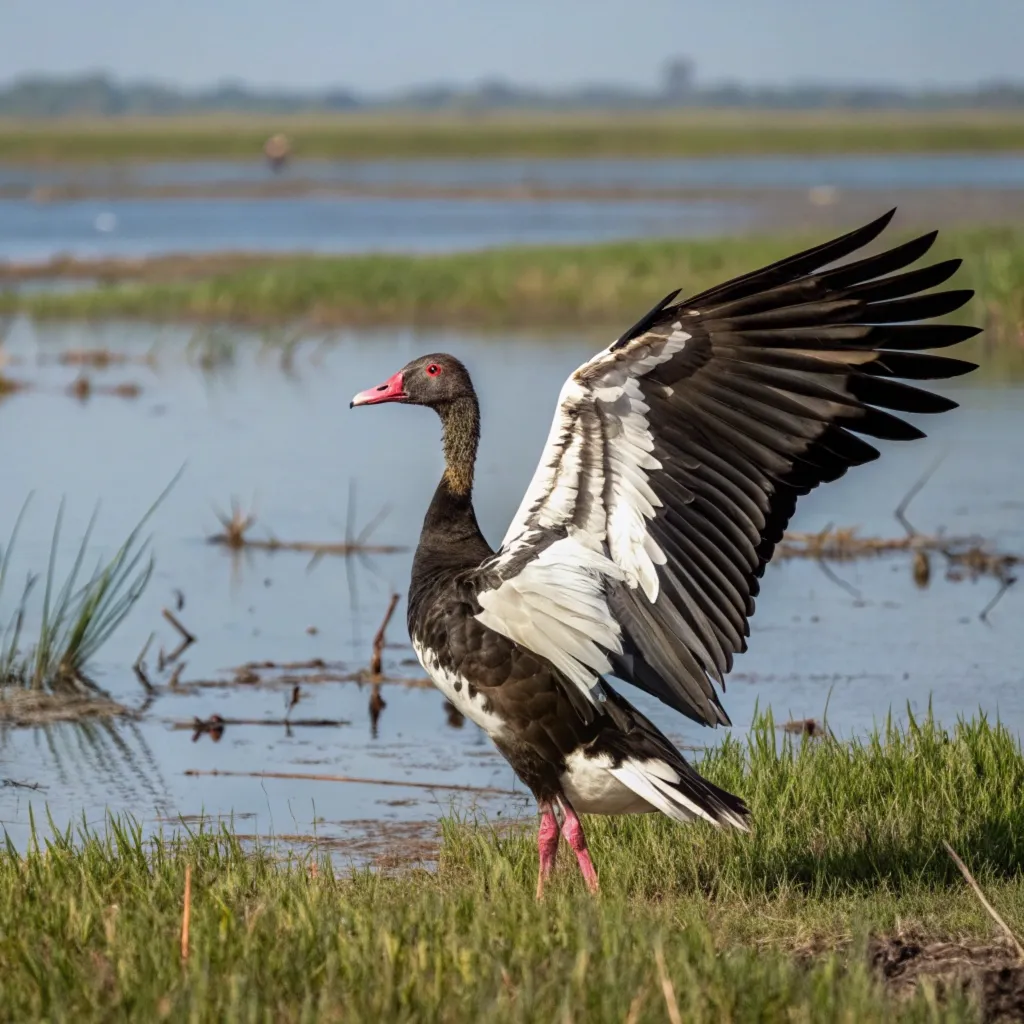
The Spur-Winged Goose (Plectropterus gambensis) is one of the largest waterfowl species in Africa and is known for its impressive flight speed.
These birds can reach velocities of up to 142 km/h (88 mph) during level flight, making them one of the fastest flying waterfowl.
Their large size, combined with powerful wing muscles and a streamlined body, contributes to their remarkable speed.
The spur on their wings, which gives them their name, is used for defense and does not directly contribute to their flying ability.Adaptation to diverse habitats plays a significant role in the Spur-Winged Goose’s flight capabilities.
These birds inhabit a variety of wetland environments across sub-Saharan Africa, from coastal lagoons to inland swamps.
Their ability to fly swiftly allows them to cover large distances between feeding and breeding grounds, often navigating through different ecosystems.
Research into Spur-Winged Goose flight patterns has provided valuable insights into wetland conservation in Africa, as these birds serve as indicators of ecosystem health across diverse habitats.
Eurasian Teal
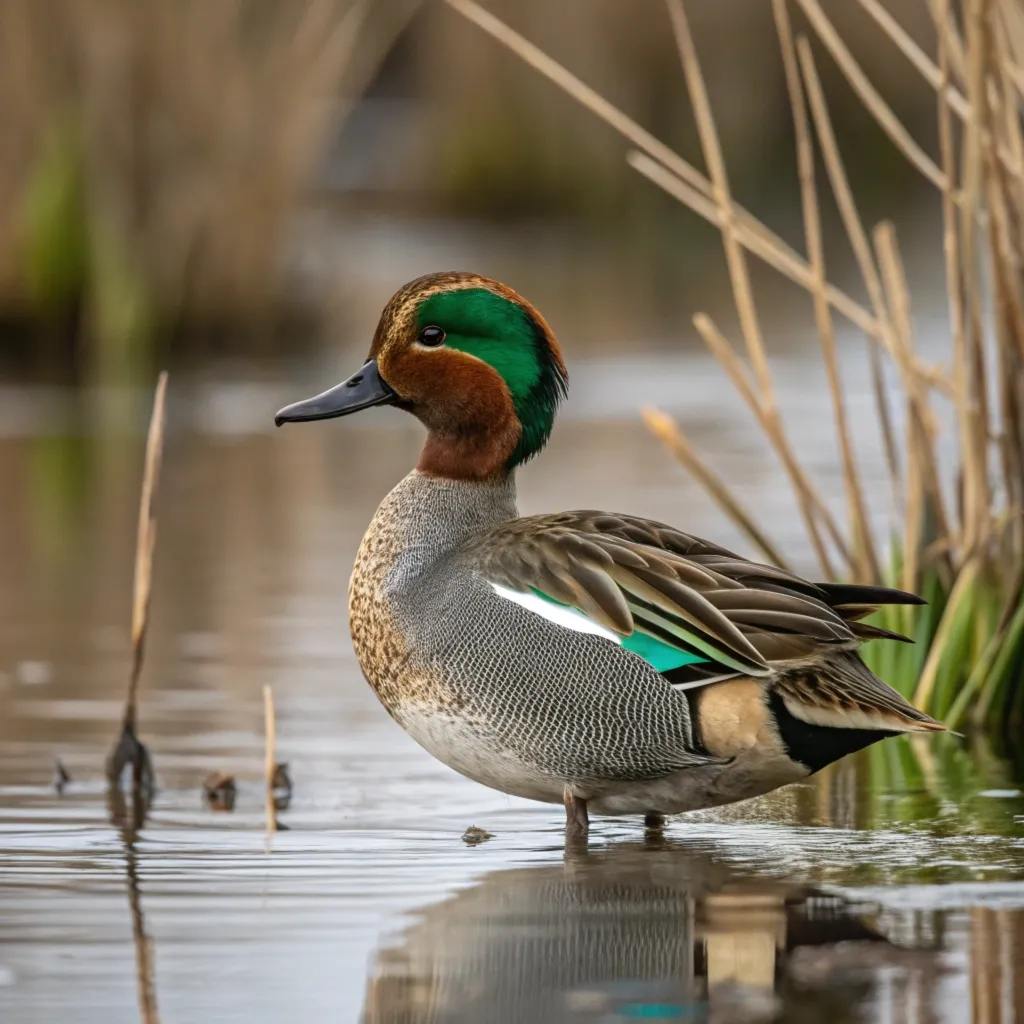
The Eurasian Teal (Anas crecca) is a small but swift dabbling duck. These birds are known for their agile flight and ability to quickly take off from water surfaces.
While not the fastest in level flight, their rapid acceleration and nimble maneuvering make them impressive flyers. Eurasian Teals can reach speeds of up to 95 km/h (59 mph) during migration or when evading predators.
Habitat adaptation plays a crucial role in the Eurasian Teal’s flight capabilities. These ducks frequent shallow wetlands and coastal areas, environments that require quick takeoffs and agile flight to navigate through vegetation.
Their small size and lightweight build contribute to their speed and maneuverability.
Eurasian Teals are also known for their long-distance migrations, covering thousands of kilometers between breeding and wintering grounds, showcasing their endurance alongside their speed.
Anna’s Hummingbird

The Anna’s Hummingbird (Calypte anna) is a speed marvel in a tiny package. These birds can reach speeds of up to 98 km/h (61 mph) during their spectacular courtship dives.
What’s even more impressive is their ability to stop almost instantly, showcasing incredible maneuverability.
Their wing beat frequency, which can exceed 50 beats per second, allows them to hover and fly in any direction, including backwards.
Research into Anna’s Hummingbird flight has revealed fascinating insights into avian biomechanics. Their unique wing structure and muscle composition allow for rapid acceleration and deceleration.
Scientists have discovered that during their courtship dives, these tiny birds experience G-forces greater than fighter pilots.
This extreme performance has inspired developments in drone technology, particularly in the design of small, agile flying robots for tasks like search and rescue operations in confined spaces.
Common Eider
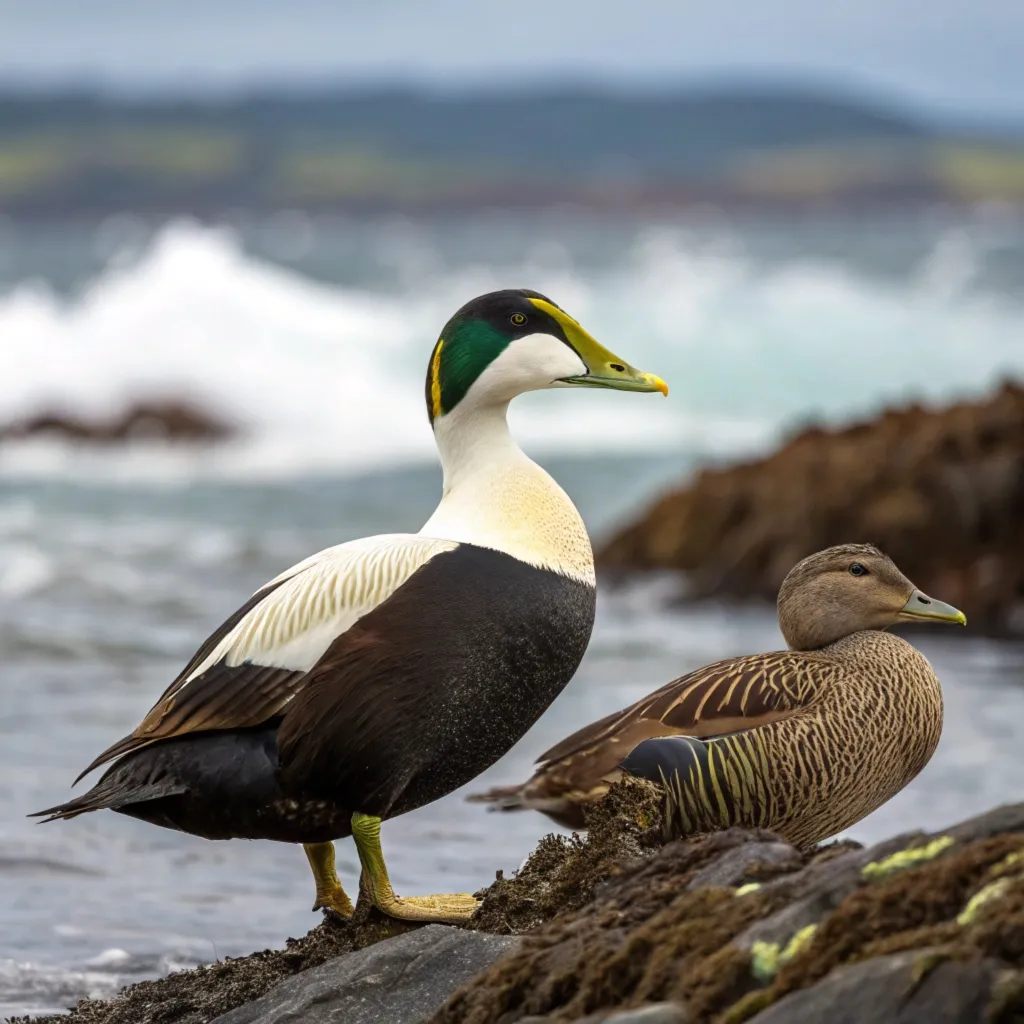
The Common Eider (Somateria mollissima) is a large sea duck known for its impressive flying speed despite its bulky appearance. These birds can reach speeds of up to 113 km/h (70 mph) during migration or when fleeing danger.
Their powerful wing muscles and streamlined body shape contribute to their surprising velocity. Common Eiders are also excellent swimmers and divers, showcasing their versatility in both air and water environments.
Adaptation to harsh environments plays a significant role in the Common Eider’s flight capabilities. These ducks inhabit cold, northern coastal areas, where quick and efficient flight is crucial for survival.
Their dense plumage, which provides excellent insulation in cold waters, also aids in maintaining an aerodynamic shape during flight.
Research into Common Eider flight patterns has provided valuable insights into bird migration strategies in Arctic regions, contributing to our understanding of how climate change may impact these important flyways.
Grey-Headed Albatross
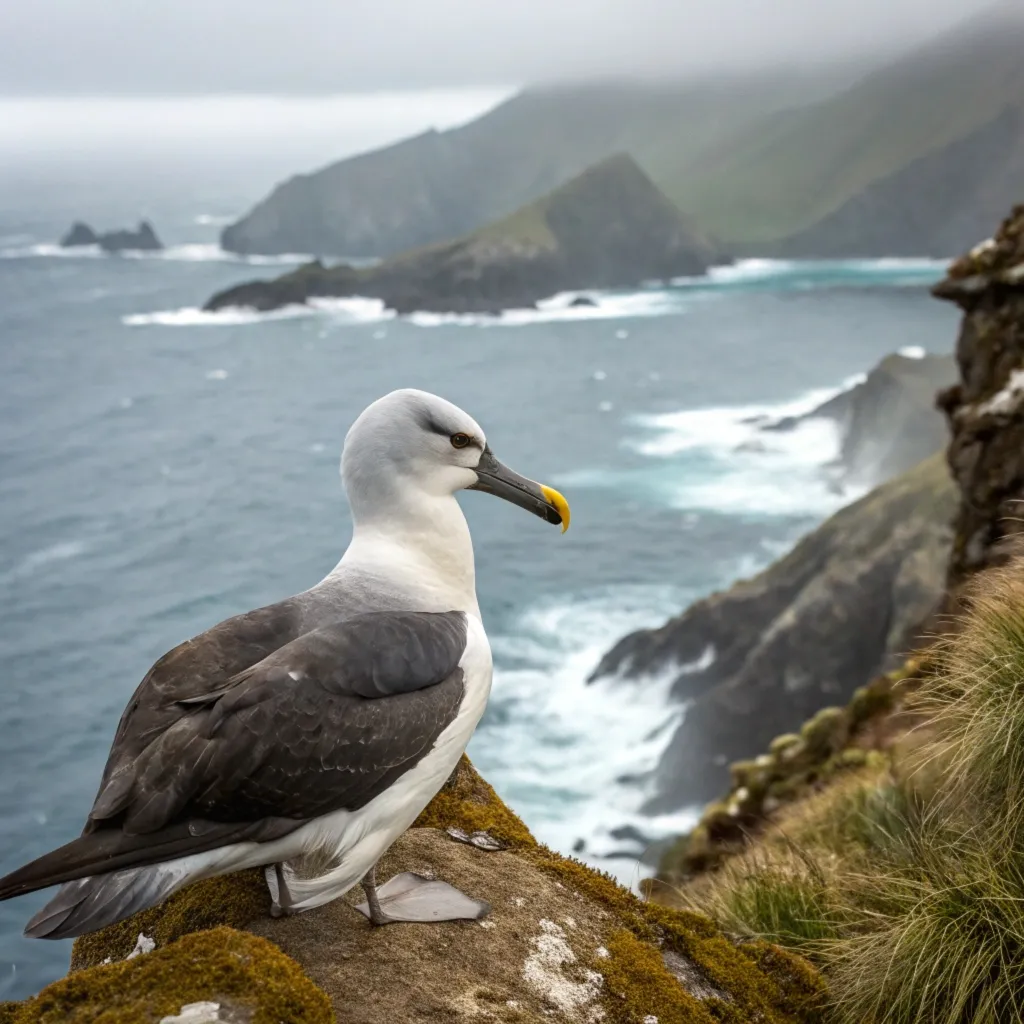
The Grey-Headed Albatross (Thalassarche chrysostoma) is renowned for its long-distance flying abilities and impressive speed. These seabirds can reach speeds of up to 127 km/h (79 mph) when riding strong oceanic winds.
Their enormous wingspan, which can exceed 2 meters, allows them to glide effortlessly for hours, covering vast distances with minimal energy expenditure.
Grey-Headed Albatrosses are known to circumnavigate the globe in just 46 days, showcasing their incredible endurance and speed.
Research into Grey-Headed Albatross flight has provided valuable insights into oceanic wind patterns and climate change impacts.
These birds are highly adapted to utilize global wind systems, and changes in these patterns due to climate change could significantly affect their migration routes and breeding success.
Scientists use data from albatross flights to better understand atmospheric dynamics over remote ocean areas, contributing to improved weather forecasting and climate models.
The study of these remarkable birds continues to bridge the gap between ornithology and atmospheric sciences.
Canvasback

The Canvasback (Aythya valisineria) is a large diving duck known for its swift flight. These birds can reach speeds of up to 116 km/h (72 mph) during migration or when fleeing danger.
Their distinctive wedge-shaped head and long, sloping bill contribute to their aerodynamic profile, allowing them to cut through the air efficiently.
Canvasbacks are also strong swimmers and divers, adapting well to both aerial and aquatic environments.
Habitat preferences play a crucial role in the Canvasback’s flight capabilities. These ducks frequent deep water bodies and coastal bays, environments that require rapid takeoffs and landings.
Their powerful wing muscles and streamlined body shape enable quick acceleration from water surfaces.
Research into Canvasback flight patterns has provided valuable insights into wetland conservation strategies, as these birds serve as indicators of ecosystem health in their breeding and wintering grounds.
Understanding their speed and migration routes helps conservationists protect critical habitats along their flyways.
Red-Tailed Hawk

The Red-Tailed Hawk (Buteo jamaicensis) is a large bird of prey known for its impressive flying speed and hunting prowess. These hawks can reach speeds of up to 190 km/h (120 mph) during hunting dives.
Their broad wings and rounded tail provide excellent maneuverability, allowing them to navigate through complex environments while maintaining high speeds.
Red-Tailed Hawks are adaptable predators, found in a variety of habitats across North America.
Research into Red-Tailed Hawk flight patterns has revealed fascinating insights into raptor aerodynamics.
Scientists have studied how these birds use thermal updrafts and wind currents to conserve energy during long flights.
Their ability to soar efficiently allows them to cover large territories with minimal effort. This research has applications in drone technology, particularly in developing unmanned aerial vehicles that can operate in diverse environments with high endurance.
Gyrfalcon
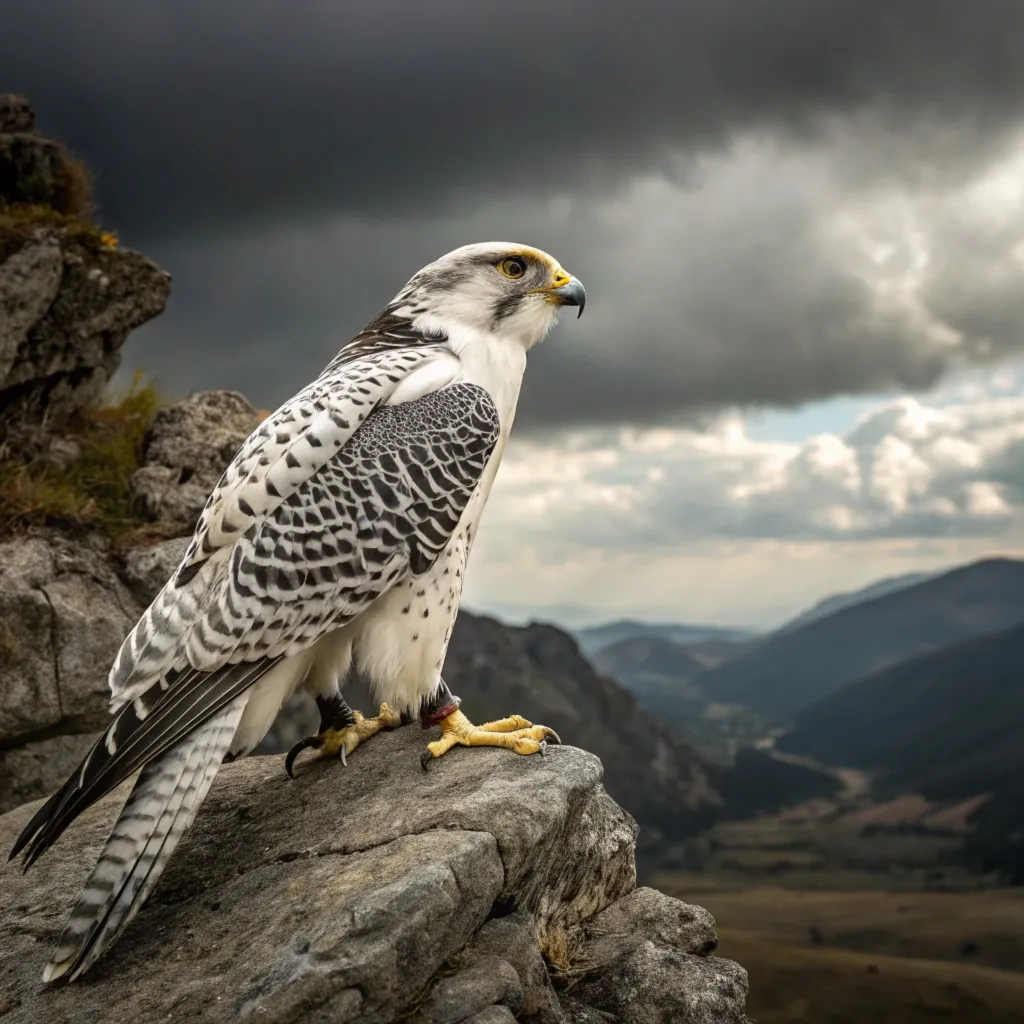
The Gyrfalcon (Falco rusticolus) is the largest of the falcon species and is renowned for its impressive speed and power in flight. These birds can reach speeds of up to 209 km/h (130 mph) during hunting dives.
Their large size and muscular build contribute to their ability to achieve and maintain high velocities.
Gyrfalcons are adapted to life in the Arctic and subarctic regions, where their speed and agility make them formidable hunters.
Adaptation to extreme environments plays a crucial role in the Gyrfalcon’s flight capabilities.
These birds have evolved to thrive in harsh Arctic conditions, where efficient flight is essential for survival. Their thick plumage provides insulation without compromising aerodynamics.
Research into Gyrfalcon flight behavior has provided valuable insights into avian adaptations to cold climates. Scientists study these birds to better understand how climate change may impact Arctic ecosystems and the species that depend on them.
Emu

The Emu (Dromaius novaehollandiae) is the largest bird native to Australia and, while flightless, is known for its impressive running speed.
These birds can reach speeds of up to 50 km/h (31 mph) when sprinting. Their powerful legs and aerodynamic body shape allow them to cover large distances efficiently.
Emus are well-adapted to the harsh Australian outback, where their speed serves as both a means of travel and a defense against predators.
Research into Emu locomotion has provided valuable insights into bipedal movement and energy efficiency in large birds.
Scientists have studied how these birds maintain balance and stability at high speeds, despite their considerable size.
This research has applications in biomechanics and robotics, particularly in the development of bipedal robots designed for rough terrain.
Additionally, understanding Emu movement patterns contributes to conservation efforts, helping to design wildlife corridors and protected areas that accommodate these birds’ need for space and mobility.
Greater Rhea

The Greater Rhea (Rhea americana) is a large flightless bird native to South America, known for its impressive running speed.
These birds can reach velocities of up to 60 km/h (37 mph) when sprinting. Their long, powerful legs and reduced wings that act as balancing aids contribute to their swift ground movement.
Greater Rheas inhabit open grasslands and savanna regions, where their speed is crucial for evading predators.
Adaptation to open habitats plays a significant role in the Greater Rhea’s locomotion capabilities. These birds have evolved to thrive in expansive grasslands, where the ability to cover large distances quickly is advantageous.
Research into Greater Rhea movement patterns has provided insights into flightless bird evolution and ecosystem dynamics in South American grasslands.
Scientists study these birds to better understand how large, flightless species adapt to changing environments and how they influence vegetation patterns through their grazing and seed dispersal behaviors.
Ostrich

The Ostrich (Struthio camelus) is the largest living bird species and is renowned for its impressive running speed.
These flightless birds can reach velocities of up to 70 km/h (43 mph) in short bursts and can maintain speeds of 50 km/h (31 mph) over longer distances.
Their long, powerful legs and aerodynamic body shape contribute to their remarkable ground speed.
Ostriches are native to Africa and are well-adapted to life in open savannas and grasslands.
Research into Ostrich locomotion has revealed fascinating insights into bipedal movement and energy efficiency.
Scientists have studied how these birds achieve such high speeds with minimal energy expenditure. Their unique two-toed feet and specialized leg muscles allow for efficient, springy strides.
This research has applications in biomechanics and robotics, particularly in the development of energy-efficient bipedal robots.
Understanding Ostrich movement also contributes to conservation efforts, helping to design protected areas that accommodate these birds’ need for space and mobility in their natural habitats.
Gentoo Penguin
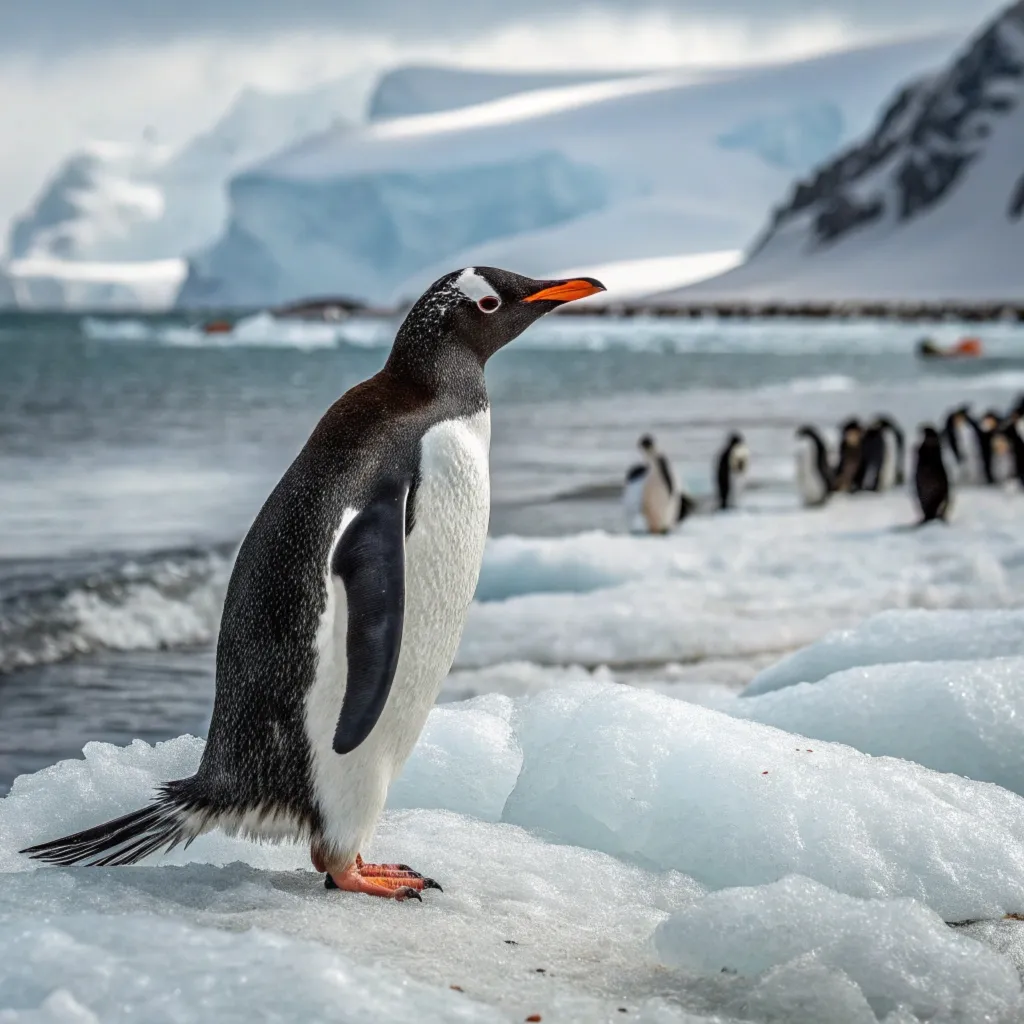
The Gentoo Penguin (Pygoscelis papua) is known as the fastest swimming bird, showcasing impressive speed in water despite being flightless on land.
These penguins can reach speeds of up to 36 km/h (22 mph) while swimming, making them the swiftest of all penguin species.
Their streamlined body shape, powerful flippers, and hydrodynamic feathers contribute to their remarkable aquatic speed.
Gentoo Penguins inhabit sub-Antarctic islands and the Antarctic Peninsula, where their swimming prowess is crucial for hunting and evading predators.
Adaptation to aquatic environments plays a significant role in the Gentoo Penguin’s speed capabilities.
These birds have evolved to thrive in cold, turbulent waters, where efficient movement is essential for survival.
Research into Gentoo Penguin swimming mechanics has provided valuable insights into marine animal locomotion and energy conservation in cold environments.
Scientists study these birds to better understand how marine animals optimize their movement in water, which has applications in fields such as underwater vehicle design and marine conservation.
The Gentoo Penguin’s ability to maintain high speeds in water showcases the diverse ways in which birds have adapted to different environments, even when traditional flight is not an option.
Factors Influencing Bird Flight Speeds
Several factors contribute to the impressive speeds achieved by birds:
- Body Shape: Streamlined forms reduce air resistance.
- Wing Design: Different wing shapes optimize for speed or maneuverability.
- Muscle Power: Strong flight muscles generate propulsion.
- Diving vs. Level Flight: Gravity assists in achieving higher speeds during dives.
- Wind Conditions: Tailwinds can significantly boost flight speeds.
- Measurement Methods: Radar, GPS tracking, and visual estimates can yield different results.
The complex interplay of factors influencing bird flight speeds showcases the remarkable adaptability of avian species. Each bird’s unique combination of physical attributes and behavioral strategies has been fine-tuned by evolution to suit its specific ecological niche.
For instance, peregrine falcons have evolved pointed wings and a streamlined body for high-speed dives, while frigatebirds have developed enormous wingspans for efficient soaring.
Understanding these adaptations provides valuable insights into the principles of aerodynamics and energy efficiency in flight.
Ongoing research into bird flight speeds continues to reveal new insights and challenge our understanding of avian capabilities. Advanced tracking technologies and high-speed imaging techniques are allowing scientists to measure bird speeds with unprecedented accuracy.
These studies not only enhance our knowledge of bird biology but also have practical applications in fields such as aviation and robotics.
By studying how birds achieve and maintain high speeds, engineers are developing more efficient aircraft designs and improving the performance of unmanned aerial vehicles for various applications.
Importance of Speed in Avian Life
Fast flight serves several crucial purposes for birds:
- Hunting: Predatory birds use speed to catch agile prey.
- Escape: Swift flight helps birds evade predators.
- Migration: Rapid travel allows birds to cover vast distances efficiently.
- Mating Displays: Some species incorporate high-speed dives or chases in courtship rituals.
The importance of speed in avian life extends beyond mere survival; it plays a crucial role in shaping bird behavior and ecology. For predatory birds, speed is often the difference between a successful hunt and going hungry.
Conservation Considerations
While many fast-flying birds have stable populations, some face challenges:
- Habitat Loss: Destruction of nesting sites and hunting grounds threatens some species.
- Climate Change: Shifting weather patterns may impact migration routes and food availability.
- Collisions: High-speed flight increases risks of collisions with human-made structures.
Conservation efforts focus on:
- Protecting critical habitats
- Reducing pesticide use
- Implementing bird-friendly building designs
The conservation of fast-flying birds presents unique challenges due to their specific adaptations and behaviors. For example, the Peregrine Falcon, once threatened by DDT use, has made a remarkable recovery thanks to dedicated conservation efforts.
However, other species like the Saker Falcon face ongoing threats due to habitat loss and illegal trapping for falconry.
Conservation strategies must consider the wide-ranging territories and migratory patterns of these birds, often requiring international cooperation.
Research into bird flight continues to inform conservation practices. Understanding the aerodynamics of high-speed flight helps scientists design more effective wind turbines and building structures to reduce bird collisions.
Additionally, tracking technologies used to study fast-flying birds provide valuable data on migration routes and habitat use, enabling more targeted conservation efforts.
These studies not only benefit the birds themselves but also contribute to broader ecological knowledge and technological innovations.
FAQs About the World’s Fastest Birds
How do scientists measure bird flight speeds?
Scientists use various methods to measure bird flight speeds, including:
- Radar tracking
- GPS devices attached to birds
- High-speed cameras
- Doppler shift measurements
Each method has advantages and limitations, which can lead to variations in reported speeds.
Can birds maintain their top speeds for long periods?
Most birds cannot sustain their maximum speeds for extended durations. Top speeds are typically achieved in short bursts, such as during hunting dives or escape maneuvers. Sustained flight usually occurs at lower speeds to conserve energy.
Do all fast-flying birds have similar wing shapes?
While many fast birds have long, pointed wings, wing shapes vary based on specific adaptations. Some species, like falcons, have tapered wings for high-speed dives, while others, like swifts, have crescent-shaped wings for agile, sustained flight.
How does bird speed compare to other flying animals?
Birds generally achieve higher speeds than other flying animals like bats or insects. However, some insects, such as dragonflies, can achieve impressive speeds relative to their size.
Are there any health risks for birds flying at such high speeds?
High-speed flight can pose risks, including:
- Potential for injury from collisions
- Increased energy expenditure
- Respiratory stress at high altitudes
However, fast-flying birds have evolved adaptations to mitigate these risks.
The study of fast-flying birds continues to yield fascinating insights into avian biology and aerodynamics.
Recent research has revealed that some species, like the Common Swift, can stay airborne for incredibly long periods, with some individuals flying non-stop for up to 10 months.
This remarkable endurance, combined with high-speed capabilities, showcases the incredible diversity of avian adaptations.

Joyce is the passionate founder of Chirping Hearts, a website dedicated to sharing her love for birds and providing valuable information about avian life. With a background in ornithology and years of experience in birdwatching, Joyce aims to inspire others to appreciate the beauty and diversity of birds. Through her engaging articles and guides, she hopes to foster a community of bird enthusiasts who share her enthusiasm for these incredible creatures. When she’s not writing, Joyce enjoys exploring nature trails and observing birds in their natural habitats.


